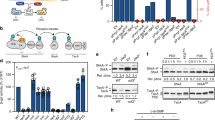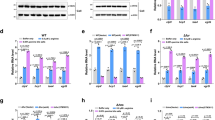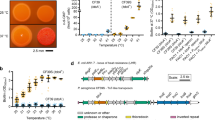Abstract
IN addition to acting as a chemotactic signal1,2, cyclic AMP induces the formation of stalk cells from undifferentiated amoebae in the cellular slime mould Dictyostelium3,4. The inductive action is specific for cyclic AMP, as AMP, ATP, ADP, GMP and GTP have no effect5. The induction also acts on Polysphondylium pallidum, a related species, even though cyclic AMP is not chemotactic for this species5,6.
This is a preview of subscription content, access via your institution
Access options
Subscribe to this journal
Receive 51 print issues and online access
$199.00 per year
only $3.90 per issue
Buy this article
- Purchase on Springer Link
- Instant access to full article PDF
Prices may be subject to local taxes which are calculated during checkout
Similar content being viewed by others
References
Konijn, T. M., van de Meene, J. G. C., Bonner, J. T., and Barkley, D. S., Proc. natn. Acad. Sci. U.S.A., 58, 1152 (1967).
Gerisch, G., Malchow, D., and Hess, B., Biochemistry of Sensory Functions (edit. by Jaenicke, L.), 279–298 (Springer, Berlin, 1974).
Bonner, J. T., Proc. natn. Acad. Sci. U.S.A., 65, 1102 (1970).
Chia, W. K., Devl Biol., 44, 239 (1975).
George, R. P., Roux Arch. Entwicklungsmech (in the press).
Konijn, T. M., Adv. Cyclic Nucleotide Res., 1, 17–31 (1972).
Sussman, M., and Sussman, R. R., Symp. Soc. gen. Microbiol., 19, 403–435 (1969).
Wicks, W. D., J. biol. Chem., 244, 3941–3950 (1969).
Jost, J.-P., Hsie, A., Hughes, S. D., and Ryan, L., J. biol. Chem., 245, 351–357 (1970).
Wicks, W. S., Adv. Cyclic Nucleotide Res., 4, 335–438 (1974).
Pastan, I., and Perlman, R. L., J. biol. Chem., 244, 2226–2232 (1969).
Rickenberg, H. V., A. Rev. Microbiol., 28, 353–369 (1974).
Wright, B. E., Critical Variables in Differentiation (Prentice-Hall, Englewood Cliffs, New Jersey, 1973).
Killick, K. A., and Wright, B. E., A. Rev. Microbiol., 28, 139–166 (1974).
Rosness, P. A., Gustafson, G., and Wright, B. E., J. Bact., 108, 1329–1337 (1971).
George, R. P., Hohl, H. R., and Raper, K. B., J. gen. Microbiol., 70, 477–479 (1972).
Gerisch, G., Naturwissenschaften, 46, 654–656 (1959).
Jones, W. R. III, and Francis, D., Biol. Bull., 142, 461–469 (1972).
Laemmli, U. K., Nature, 227, 680–685 (1970).
McGuire, K. C., Pène, J. J., and Barrow-Carroway, J., J. Virol., 13, 690–698 (1974).
Author information
Authors and Affiliations
Rights and permissions
About this article
Cite this article
FRANCIS, D. Cyclic AMP-induced changes in protein synthesis in a cellular slime mould, Polysphondylium pallidum. Nature 258, 763–765 (1975). https://doi.org/10.1038/258763a0
Received:
Accepted:
Issue Date:
DOI: https://doi.org/10.1038/258763a0
This article is cited by
Comments
By submitting a comment you agree to abide by our Terms and Community Guidelines. If you find something abusive or that does not comply with our terms or guidelines please flag it as inappropriate.



